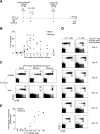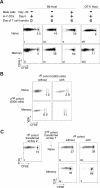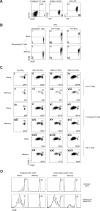Antigen-specific T-T interactions regulate CD4 T-cell expansion
- PMID: 18539897
- PMCID: PMC2515122
- DOI: 10.1182/blood-2007-09-114389
Antigen-specific T-T interactions regulate CD4 T-cell expansion
Abstract
The regulation of CD4 T-cell numbers during an immune response should take account of the amount of antigen (Ag), the initial frequency of Ag-specific T cells, the mix of naive versus experienced cells, and (ideally) the diversity of the repertoire. Here we describe a novel mechanism of T-cell regulation that potentially deals with all of these parameters. We found that CD4 T cells establish a negative feedback loop by capturing their cognate major histocompatibility class (MHC)/peptide complexes from Ag-presenting cells and presenting them to Ag-experienced CD4 T cells, thereby inhibiting their recruitment into the response while allowing recruitment of naive T cells. The inhibition is Ag specific, begins at day 2 (long before Ag disappearance), and cannot be overcome by providing new Ag-loaded dendritic cells. In this way, CD4 T-cell proliferation is regulated in a functional relationship to the amount of Ag, while allowing naive T cells to generate repertoire variety.
Figures







Similar articles
-
Tumor-specific CD4+ T cells are activated by "cross-dressed" dendritic cells presenting peptide-MHC class II complexes acquired from cell-based cancer vaccines.J Immunol. 2006 Feb 1;176(3):1447-55. doi: 10.4049/jimmunol.176.3.1447. J Immunol. 2006. PMID: 16424172
-
Differential kinetics of antigen dependency of CD4+ and CD8+ T cells.J Immunol. 2014 Apr 15;192(8):3507-17. doi: 10.4049/jimmunol.1302725. Epub 2014 Mar 17. J Immunol. 2014. PMID: 24639353
-
Concerted antigen presentation by dendritic cells and B cells is necessary for optimal CD4 T-cell immunity in vivo.Immunology. 2005 Aug;115(4):556-64. doi: 10.1111/j.1365-2567.2005.02196.x. Immunology. 2005. PMID: 16011524 Free PMC article.
-
How Does B Cell Antigen Presentation Affect Memory CD4 T Cell Differentiation and Longevity?Front Immunol. 2021 Jun 10;12:677036. doi: 10.3389/fimmu.2021.677036. eCollection 2021. Front Immunol. 2021. PMID: 34177919 Free PMC article. Review.
-
The role of B cell antigen presentation in the initiation of CD4+ T cell response.Immunol Rev. 2020 Jul;296(1):24-35. doi: 10.1111/imr.12859. Epub 2020 Apr 18. Immunol Rev. 2020. PMID: 32304104 Review.
Cited by
-
ERAP1 functions override the intrinsic selection of specific antigens as immunodominant peptides, thereby altering the potency of antigen-specific cytolytic and effector memory T-cell responses.Int Immunol. 2014 Dec;26(12):685-95. doi: 10.1093/intimm/dxu078. Epub 2014 Aug 2. Int Immunol. 2014. PMID: 25087231 Free PMC article.
-
Antigen Presentation by MHC-Dressed Cells.Front Immunol. 2015 Jan 5;5:672. doi: 10.3389/fimmu.2014.00672. eCollection 2014. Front Immunol. 2015. PMID: 25601867 Free PMC article. Review.
-
Evolving immune circuits are generated by flexible, motile, and sequential immunological synapses.Immunol Rev. 2013 Jan;251(1):80-96. doi: 10.1111/imr.12021. Immunol Rev. 2013. PMID: 23278742 Free PMC article. Review.
-
Quorum Sensing by Monocyte-Derived Populations.Front Immunol. 2019 Sep 11;10:2140. doi: 10.3389/fimmu.2019.02140. eCollection 2019. Front Immunol. 2019. PMID: 31572366 Free PMC article. Review.
-
CD4+ T cells in cancer.Nat Cancer. 2023 Mar;4(3):317-329. doi: 10.1038/s43018-023-00521-2. Epub 2023 Mar 9. Nat Cancer. 2023. PMID: 36894637 Review.
References
-
- Dutton RW, Bradley LM, Swain SL. T cell memory. Annu Rev Immunol. 1998;16:201–223. - PubMed
-
- Ahmed R, Gray D. Immunological memory and protective immunity: understanding their relation. Science. 1996;272:54–60. - PubMed
-
- Sprent J, Surh CD. T cell memory. Annu Rev Immunol. 2002;20:551–579. - PubMed
-
- Merica R, Khoruts A, Pape KA, Reinhardt RL, Jenkins MK. Antigen-experienced CD4 T cells display a reduced capacity for clonal expansion in vivo that is imposed by factors present in the immune host. J Immunol. 2000;164:4551–4557. - PubMed
-
- Badovinac VP, Porter BB, Harty JT. CD8+ T cell contraction is controlled by early inflammation. Nat Immunol. 2004;5:809–817. - PubMed
Publication types
MeSH terms
Substances
Grants and funding
LinkOut - more resources
Full Text Sources
Other Literature Sources
Molecular Biology Databases
Research Materials

